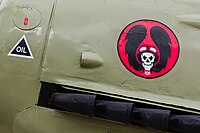101 Squadron (Israel)

Multi tool use
| 101st Squadron | |
|---|---|
 Avia S-199 with the 101st Squadron badge | |
| Active | May 20, 1948 – Present |
| Country | |
| Branch | |
| Role | Air Defence |
| Garrison/HQ | Hatzor Airbase |
| Nickname(s) | First Fighter Squadron |
| Commanders | |
| Notable commanders |
Modi Alon Avraham Lanir |
| Insignia | |
| Avia S-199 of 101 Squadron |  |
| Aircraft flown | |
| Fighter | F-16C |
101 Squadron of the Israeli Air Force, also known as the First Fighter Squadron, is Israel's first fighter squadron, formed on May 20, 1948, six days after Israel declared its independence. Initially flying the Avia S-199, it has since operated the Supermarine Spitfire, North American Mustang, Dassault Mystere IV, Dassault Mirage IIICJ, IAI Nesher and IAI Kfir. It currently operates out of Hatzor Airbase, flying the F-16C Fighting Falcon.
Contents
1 History
2 See also
3 References
4 External links
History
101 Squadron was formed on May 20, 1948, at two air bases simultaneously: IAF Ekron (former RAF Aqir, currently Tel-Nof Airbase) and Žatec (code-named "Zebra") in northwestern Czechoslovakia, a former Luftwaffe airfield close to a Messerschmitt production facility, where pilots received initial basic type flight training on the Avia S-199s, Czechoslovak-built copies of the Bf 109G with 1,320 hp Junkers Jumo 211F powerplants. During one ferry flight some of the squadron's 15 aircraft were forced to land in Greece, and were immediately impounded, so during the next ferry flight a C-46 was used as a navigation guide, and a corvette was readied off the coast in case any aircraft had to be ditched and pilots rescued from water.[1] Four of these flew the squadron's first mission on May 29, strafing the Egyptian ground forces near Ad Halom, in the prelude to Operation Pleshet. 101 Squadron was responsible for the Israeli Air Force's first aerial victories when on 3 June 1948, Modi Alon, after taking off from Herzliya Airport, shot down a pair of Royal Egyptian Air Force C-47s which had just bombed Tel Aviv.[2][3]
A makeshift strip located around the current Herzliya Airport was the main operating base of the squadron between June and October 1948, and the squadron moved to it after un-assembled planes were strafed on the ground on May 30th. The airfield was used as it was a bit back from the front-lines, and was clandestine since it was a purpose built strip, that was constructed after the beginning of hostilities, in between the orange orchards around Herzliya, and didn't appear on published maps. During these initial operations, the squadron operated with a few planes versus almost complete Arab theater Air supremacy and the airplanes were parked dispersed between the orange trees. The squadron was moved in October to Hatzor Airbase from the strip in due to its unsuitability in rainy conditions, probable loss of clandestine status, moving front lines which made former British bases safe for use, and a shift in the balance of air superiority towards the Israelis. [4][5][6]
See also
- Christopher Magee
- Milton Rubenfeld
- Mitchell Flint
- Gordon Levett
- Giora Epstein
- Bob Vickman
- Yiftah Spector
- Ezer Weizman
- Avraham Lanir
- Rimon 20
References
| Wikimedia Commons has media related to Squadron 101 (Israeli Air Force). |
^ Luttrell, Robert J., I flew for Israel, Flying Magazine, May 1949, p.58
^ Aloni, Shlomo (2001). Arab–Israeli Air Wars. Osprey Publishing. p. 11. ISBN 1-84176-294-6..mw-parser-output cite.citation{font-style:inherit}.mw-parser-output q{quotes:"""""""'""'"}.mw-parser-output code.cs1-code{color:inherit;background:inherit;border:inherit;padding:inherit}.mw-parser-output .cs1-lock-free a{background:url("//upload.wikimedia.org/wikipedia/commons/thumb/6/65/Lock-green.svg/9px-Lock-green.svg.png")no-repeat;background-position:right .1em center}.mw-parser-output .cs1-lock-limited a,.mw-parser-output .cs1-lock-registration a{background:url("//upload.wikimedia.org/wikipedia/commons/thumb/d/d6/Lock-gray-alt-2.svg/9px-Lock-gray-alt-2.svg.png")no-repeat;background-position:right .1em center}.mw-parser-output .cs1-lock-subscription a{background:url("//upload.wikimedia.org/wikipedia/commons/thumb/a/aa/Lock-red-alt-2.svg/9px-Lock-red-alt-2.svg.png")no-repeat;background-position:right .1em center}.mw-parser-output .cs1-subscription,.mw-parser-output .cs1-registration{color:#555}.mw-parser-output .cs1-subscription span,.mw-parser-output .cs1-registration span{border-bottom:1px dotted;cursor:help}.mw-parser-output .cs1-hidden-error{display:none;font-size:100%}.mw-parser-output .cs1-visible-error{font-size:100%}.mw-parser-output .cs1-subscription,.mw-parser-output .cs1-registration,.mw-parser-output .cs1-format{font-size:95%}.mw-parser-output .cs1-kern-left,.mw-parser-output .cs1-kern-wl-left{padding-left:0.2em}.mw-parser-output .cs1-kern-right,.mw-parser-output .cs1-kern-wl-right{padding-right:0.2em}
^ Norton, Bill (2004). Air War on the Edge – A History of the Israel Air Force and its Aircraft since 1947. Midland Publishing. pp. 110–112. ISBN 1-85780-088-5.
^ "How Nazi Fighter Planes Saved Israel War Is Boring, 2016-15-08". Archived from the original on 2016-09-07. Retrieved 2017-03-15.
^ Herzliya Airfield - first days, AOPA Israel, 2014-04-22
^ Herzliya Interdisciplinary Center: The base that made history, Walla!, 2003-05-08
External links
- Global Security Profile
- 101 Squadron, Israel's first fighter squadron
Katz, Yaakov (July 16, 2012). "'It was all destiny' - One of the last surviving founders of IAF recalls mission that stopped Egypt from advancing on Tel Aviv". The Jerusalem Post. Retrieved April 23, 2013.
G1r3HddYtVsz2wVjW,KITSA 8Lf wOLt v4 d McVF YiQIA3If xdMCUsy7yMwHYiz3PU9

